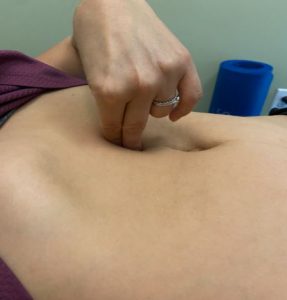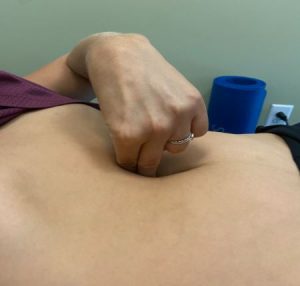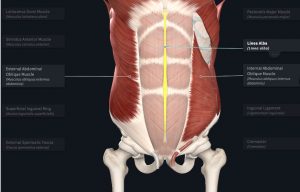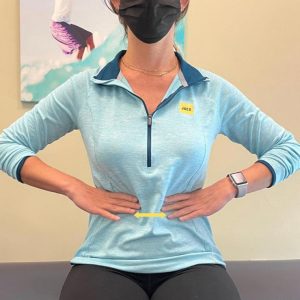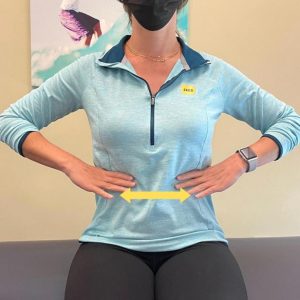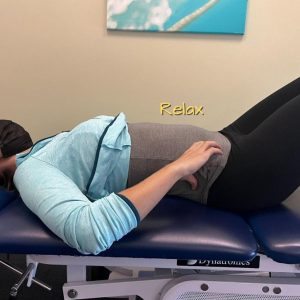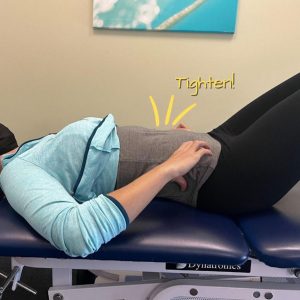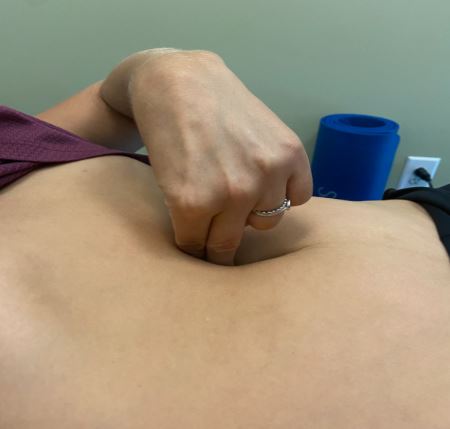
Have you ever been told by a doctor or healthcare provider that you have separation of your abdominal muscles? This condition is known as diastasis rectus abdominis (DRA), or diastasis recti.
Diastasis recti can lead to reduced core function and strength. This can look like:
- Difficulty rolling out of bed
- Low back pain with bending, lifting, and carrying
- Feeling uncoordinated during workouts of recreational activities
You may also see or feel a change in your abdominal wall. A “soft spot” may be present in the center of your abdomen, as shown below.
- In the upper abs, fingers hit resistance at connective tissue.
- As you go lower, you may hit a “soft spot”.
Attending physical therapy can help you restore core strength, heal your diastasis, and get you back to your daily activities with less difficulty. (3)
What is Diastasis Recti?
Diastasis recti is a condition in which the connective tissue in the center of your abdominal muscles, the linea alba, becomes overstretched or torn. You may be able to see a visible dip or bulge in the center of the abdominal region when trying to perform abdominal exercises.
- Linea Alba (highlighted) | Image courtesy of Complete Anatomy
This condition is common following pregnancy but can also be found in people with connective tissue disorders or poor abdominal pressure management. Diastasis recti can even be found in people who overtrain the core. (4)
And YES, men can get diastasis recti too, but the condition may be more likely to be misdiagnosed. Keep your eyes out for an upcoming post about diastasis recti in men specifically.
Why Is It Important to Treat Diastasis Recti?
Diastasis recti can make everyday activities more difficult.
Your core is in charge of stabilization and force transference. Good core function can help control forces that transfer across the trunk from your legs to your upper body, and vice versa.
Having a “soft spot” in the core can contribute to core weakness, back pain, and pelvic floor dysfunction. (4)
Physical therapy can be life-changing by restoring core function and improving your confidence performing daily tasks and activities.
What Outcomes Should I Expect?
The primary focus of physical therapy should not be on solely “pulling” the rectus halves back together.
As reported in a clinical review earlier this year from the Journal of Women’s Health Physical Therapy, inter-rectus distance (the width between the two halves of the six pack muscle) may not be the most functional outcome measure. (2)
Instead, we first want to focus on ensuring a person has strong deep core muscles, especially transverse abdominis. Then we should incorporate balanced strengthening of all of the abdominal muscles.
Activation of the deep core can make the “sinking in” or “bulging out” appearance less severe. This is because the linea alba is maintaining appropriate tension which reduces that soft spot. Appropriate tissue tension also promotes healing. (5)
Aside from this, cosmetic outcomes may vary from person to person, and can depend on how long you have had a diastasis and what caused it.
What to Expect During Physical Therapy for Diastasis Recti
During your sessions, the physical therapist will screen for dysfunction “above and below.” This is to see if other structures around the injury could be contributing to the problem.
When dealing with core dysfunction, it is important to look beyond just the abdominals and also screen for any problems with the respiratory diaphragm or pelvic floor. They are core muscles too!
This screening may include an analysis of how you breathe when doing core exercises and some questions to rule out pelvic floor dysfunction.
If you do have pelvic floor dysfunction, you may be more appropriate for a pelvic health physical therapist.
You will get some exercises to perform at home. It is important to continue these exercises outside of the clinic for best results. At follow-up visits, your therapist will monitor progress, review exercises, and progress you as appropriate.
What Kind of Exercises Can I Do for Diastasis Recti?
Below are two exercises that you can do for better core function. They are safe for people with diastasis recti.
This type of core strengthening starts pretty simple, but it is the basis for a progressive core strengthening program! Technique with advanced core exercises can be tricky with a diastasis present, but your therapist will ensure that you are performing the exercises correctly in order to get the maximum benefit.
Performing appropriate core exercises before or while pregnant can also have positive effects on occurrence and severity of diastasis recti postpartum. After being cleared by your doctor or obstetrician, attending physical therapy while pregnant can help provide you with an appropriate core program. (1, 3)
Diaphragmatic Breathing
Diaphragmatic breathing helps us to connect to our respiratory diaphragm. This exercise encourages core activation without holding your breath, especially if you have a diastasis recti. Holding your breath can cause too much pressure in your abdominal cavity and stress the linea alba further.
- Start, relaxed, ribs and hands are close.
- Inhale, ribs and hands spread out.
1. In a seated position, place your hands on the lower portion of the sides of your ribcage with your fingers wrapping around to the front.
2. Relax and breathe in deeply through your nose. Try to think of the air going into the lowest portion of your lungs, you should feel your lower ribcage expand to the side and forward. Your hands will drift further apart.
3. Blow out of your mouth like you are blowing out a candle. You should feel your lower rib cage return to the starting position. Your hands will come closer together.
Repeat for 1-2 minutes at least 2-3 times per day.
Deep Core Activation
This is the basis of all other core activities. Think of it as your foundation.
Being able to properly activate the deep core will improve trunk stability and function necessary to perform both simple and complex activities. This exercise, performed correctly, can encourage the appropriate amount of tension on the linea in order to aid in tissue healing/remodeling. (5)
- Relax with neutral spine.
- Breathe out and tighten.
1. Lay down on your back with knees bent and try to maintain a neutral spine position. Neutral spine means that you are not arching your back or forcefully trying to flatten your back.
2. Take a small breath in. As you breathe out, tighten the core. Some tips that may help to target the right muscle include trying to imagine pulling the front of your hip bones together using your muscles, or trying to pull all the muscles around your trunk toward the spine.
Hold for 5 seconds then relax. Repeat 10-15 times.
You should be able to perform this exercise without moving your spine/low back.
If exercise still feels hard to do correctly, that’s okay! We will review proper technique in the clinic.
Get Help!
Diastasis recti is a problem that can affect both men and women. If you have this condition, see a physical therapist to reduce symptoms and improve core function during daily tasks and activities you love.
Please don’t hesitate to reach out to JACO Rehab at 808-381-8947. We hope to see you in the clinic soon!
Written by Cira Pihl, PTA
References
1. Banerjee, A., et al. (2013). Effect of antenatal exercise program with and without abdominal strengthening exercises on diastasis rectus abdominis – A post partum follow up. Indian Journal of Physiotherapy and Occupational Therapy, 7(4), 123-126. Retrieved from https://www.proquest.com/scholarly-journals/effect-antenatal-exercise-program-with-without/docview/1478231439/se-2?accountid=89121
2. Berg-Poppe, P., et al. (2022). Use of exercise in the management of postpartum diastasis recti: A systematic review. Journal of Women’s Health Physical Therapy, 46(1). 35-47.
3. Gruszczyńska, D., & Truszczyńska-Baszak, A. (2018). Exercises for pregnant and postpartum women with diastasis recti abdominis: Literature review. Postepy Rehabilitacji, 32(3), 2018. doi:http://dx.doi.org/10.5114/areh.2018.80967
4. Michalska, A., et al. (2018). Diastasis recti abdominis — A review of treatment methods. Ginekologia Polska, 89(2), 97. doi: https://doi.org/10.5603/GP.a2018.0016
5. Thompson, W., et al. (2016) Understanding Mechanobiology: Physical Therapists as a Force in Mechanotherapy and Musculoskeletal Regenerative Rehabilitation, Physical Therapy 96(4), 560–569, https://doi.org/10.2522/ptj.20150224
